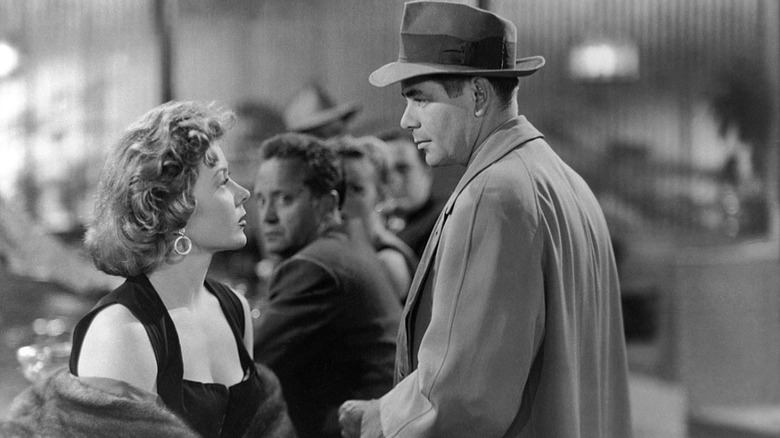10 Unmissable Film Noir Movies For Every Fan

Table of Contents
Classic Film Noir Masterpieces (1940s-1950s)
This era represents the zenith of classic film noir, establishing the genre's visual style and thematic concerns. These films are essential viewing for any serious fan.
The Maltese Falcon (1941)
John Huston's The Maltese Falcon is arguably the film that defined the genre. Humphrey Bogart's iconic performance as Sam Spade, the cynical private investigator, is legendary. The intricate plot, filled with double-crosses and unexpected twists, keeps viewers guessing until the very end.
- Director: John Huston
- Memorable Dialogue: The film is renowned for its sharp, witty, and cynical dialogue.
- Enduring Legacy: The Maltese Falcon established many of the tropes and conventions of film noir, influencing countless films that followed.
Casablanca (1942)
While often categorized separately, Casablanca embodies many quintessential film noir elements: a morally ambiguous protagonist (again, Bogart), a dangerous setting (Casablanca during World War II), and a complex love triangle with Ingrid Bergman. Its romantic and suspenseful elements combine to create a timeless classic.
- Setting: The romantic and dangerous atmosphere of Casablanca during WWII provides a rich backdrop.
- Themes: The film explores themes of love, sacrifice, and moral compromise in the face of war.
- Iconic Performances: Bogart and Bergman deliver unforgettable performances, solidifying their status as Hollywood legends.
Double Indemnity (1944)
Billy Wilder's Double Indemnity is a masterclass in suspense. Barbara Stanwyck embodies the quintessential femme fatale, manipulating Fred MacMurray into a deadly insurance scheme. The film’s dark themes and intricate plot twists make it a must-see for any film noir enthusiast.
- Director: Billy Wilder
- Plot Twists: The film is filled with unexpected turns and shocking revelations.
- Impact: Double Indemnity significantly impacted the thriller genre, influencing countless films that followed.
The Big Sleep (1946)
Based on Raymond Chandler's novel, The Big Sleep features Bogart and Lauren Bacall's sizzling on-screen chemistry. The complex plot, filled with mystery and intrigue, is a testament to Chandler's masterful storytelling. The film is a showcase of classic noir tropes and atmospheric visuals.
- Mystery Elements: The film's intricate plot keeps viewers guessing until the very end.
- Memorable Characters: The film features a cast of memorable characters, each with their own secrets and motivations.
- Literary Adaptation: A successful adaptation of a popular novel, showcasing the power of the source material.
Post-Classic and Neo-Noir Explorations (1950s-Present)
While the classic era established the genre's foundations, subsequent decades saw reinterpretations and evolutions of film noir, resulting in compelling neo-noir films.
Touch of Evil (1958)
Orson Welles's Touch of Evil is a masterpiece of visual storytelling, featuring a groundbreaking long opening shot that sets the tone for the entire film. Its morally ambiguous characters and exploration of corruption and justice remain relevant today.
- Innovative Techniques: Welles employed innovative cinematic techniques, pushing the boundaries of filmmaking.
- Themes: The film explores themes of corruption, justice, and the blurred lines between good and evil.
- Directorial Genius: Welles's directorial vision is evident in every frame of the film.
Out of the Past (1947)
This film, with its complex narrative structure and masterful use of flashbacks, perfectly captures the spirit of film noir. Robert Mitchum delivers a compelling performance as a private investigator entangled in a web of betrayal and redemption.
- Noir Tropes: The film effectively utilizes classic noir tropes, including a femme fatale and a cynical protagonist.
- Themes: The film explores themes of betrayal, redemption, and the consequences of past actions.
- Atmospheric Visuals: The film's visuals are a key element of its overall atmosphere.
Chinatown (1974)
Roman Polanski's Chinatown is a neo-noir masterpiece, featuring Jack Nicholson in a compelling performance. Its complex plot, involving corruption and water rights in 1930s Los Angeles, is both thrilling and thought-provoking.
- Director: Roman Polanski
- Iconic Characters: The film features a cast of memorable and complex characters.
- Critical Acclaim: Chinatown received widespread critical acclaim and is considered one of the greatest films ever made.
LA Confidential (1997)
Curtis Hanson's LA Confidential masterfully blends classic and modern noir elements, featuring a star-studded cast and an intricate plot involving police corruption in 1950s Los Angeles. The film's complex plot twists and turns will keep you guessing until the very end.
- Director: Curtis Hanson
- Plot Twists: The film features many surprising plot twists and turns.
- Blend of Styles: LA Confidential successfully blends classic and modern noir elements.
Brick (2005)
Rian Johnson's Brick offers a unique and refreshing take on the genre, transplanting the classic noir tropes into a high school setting. The clever dialogue and updated themes make it a must-see for fans of both film noir and clever storytelling.
- Director: Rian Johnson
- Updated Setting: The film cleverly updates the classic noir setting to a high school environment.
- Clever Dialogue: The film features sharp, witty, and memorable dialogue.
Conclusion
These 10 unmissable film noir movies represent a diverse range of styles and approaches, showcasing the enduring power and versatility of the genre. From the classic masterpieces of the 1940s and 50s to the neo-noir explorations of later decades, these films demonstrate why film noir remains a cornerstone of cinematic history. They highlight the defining characteristics of film noir: shadowy cinematography, morally ambiguous characters, cynical narratives, and explorations of crime and betrayal. These films offer a captivating glimpse into the dark side of human nature, making them essential viewing for any cinephile. Dive into the shadowy world of film noir and explore these 10 must-see films today! Discover your new favorite film noir movie and expand your appreciation for the best film noir movies ever made!

Featured Posts
-
 The Rise Of Wildfire Betting A Look At The Los Angeles Example
May 10, 2025
The Rise Of Wildfire Betting A Look At The Los Angeles Example
May 10, 2025 -
 Young Thugs Reaction To Not Like U Name Drop Post Prison Release
May 10, 2025
Young Thugs Reaction To Not Like U Name Drop Post Prison Release
May 10, 2025 -
 Ajaxs Brobbey A Formidable Force In The Europa League
May 10, 2025
Ajaxs Brobbey A Formidable Force In The Europa League
May 10, 2025 -
 Oilers Fall To Lightning 4 1 Kucherov Leads The Charge
May 10, 2025
Oilers Fall To Lightning 4 1 Kucherov Leads The Charge
May 10, 2025 -
 February 23 Nyt Strands Answers Game 357 Full Solution Guide
May 10, 2025
February 23 Nyt Strands Answers Game 357 Full Solution Guide
May 10, 2025
